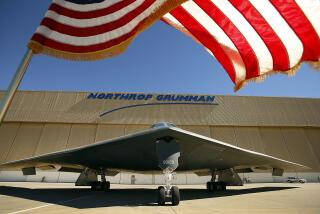Northrop Is Facing Prospect of Flying Solo
- Share via
Northrop Grumman Corp. has spent eight months prepping for its planned $11.6-billion merger with Lockheed Martin Corp. But with strong government opposition pushing the mega-deal inches from collapse, Northrop may have to resurrect its earlier game plan of staying independent and bulking up through acquisitions.
Northrop executives are quick to point out that they remain focused on the faltering merger, even as the deal’s costs mount for the Los Angeles company.
On Wednesday, Northrop said it will take a pretax charge of $180 million, or about $1.70 per share after taxes, in the first quarter of 1998 because of costs related to the Lockheed deal. Those costs could grow if the companies decide to fight the government and press their case in court.
In addition, Northrop has halted the regular transition team meetings with Lockheed employees that have been a staple for both companies for months, according to Northrop spokesman Tony Cantafio.
Northrop shares fell $1.44 to $105.50; Lockheed Martin shares rose 6 cents to $115.31 on Wednesday. Both trade on the New York Stock Exchange.
The growing caution over the Northrop-Lockheed merger stems from surprisingly strong antitrust concerns at the Department of Justice and the Defense Department, which this week sued to block the deal.
The agencies charge that the merged company would account for nearly 30% of the Defense Department’s procurement and research and development budget and would cripple competition and innovation in several areas vital to the Pentagon, including defense electronics.
Given the government’s unusually harsh stance, Northrop has been forced to consider its prospects if the merger is scuttled.
Many believe the company is strong enough to survive alongside much larger industry giants. But thriving in the shadow of Boeing, Lockheed Martin and Raytheon may be another matter.
Strategic planning has not been Northrop Chief Executive Kent Kresa’s focus lately, said Roger Threlfall, an industry analyst with JP Morgan Securities, but “he’s been given a wake-up call now to consider the alternatives.”
“Things don’t look bad at all, but it’s not going to be easy,” Threlfall said. “They have to decide where they want to compete and stay very focused.”
Indeed, Northrop remains strong, with solid profit and sales topping $9 billion last year. The firm’s backlog of business totals nearly $12 billion.
Key among its strengths are its defense electronics businesses, which match or exceed those of larger rivals. In addition, Northrop still has solid contracts to build Boeing’s 747 fuselages on the commercial side and the B-2 bomber, C-17 tanker and F/A-18 fighter on the military side.
But for Northrop to grow, it will need to build on its role as a second-tier contractor.
“Survival isn’t the issue, at least for the next few years,” said Wolfgang Demisch, an analyst with BT Alex. Brown. “But the question will be, can it flourish in a no-growth defense budget against bigger competitors?”
To help boost its chances, Northrop will have to jump back into the acquisition market.
“You can’t stand still if the larger and smaller companies are still moving,” said Mike Goldberg, a partner in the aerospace practice at Deloitte & Touche.
Before the deal to merge with Bethesda, Md.-based Lockheed was announced last July, Northrop had completed a number of acquisitions, including LTV Vought Aircraft, Westinghouse’s electronics systems unit and Logicon.
It appears unlikely that another big player would buy Northrop or vice versa. But Northrop could pursue smaller targets, such as the defense electronics businesses at Litton Industries Inc. or ITT Corp.
Northrop executives aren’t tipping their hand. But Wednesday’s write-off announcement sent clear signs the company is looking ahead.
Up to $160 million of the write-off covers the cost of vesting restricted stock that was issued to executives after shareholders approved the plan--and the Lockheed merger--last month. The remainder of the charge covers investment banking, legal and accounting fees related to the merger, the company said.
The top five Northrop executives, who stand to pocket about $34 million in restricted stock alone under the plan, have each voluntarily agreed to attach a new restriction to the shares--one that subjects the shares to forfeiture if the executive leaves Northrop for another job within two years.
In an effort to head off a management exodus amid the company’s uncertain future, Northrop said it also expanded a new stock-based retention plan beyond its top ranks to cover an estimated 2,000 managers, providing they agree to the two-year restriction.
“The goal of this is to make sure people stay focused during this uncertain period,” Cantafio said. “The bottom line is that we’ve put together a very viable company.”
More to Read
Inside the business of entertainment
The Wide Shot brings you news, analysis and insights on everything from streaming wars to production — and what it all means for the future.
You may occasionally receive promotional content from the Los Angeles Times.








